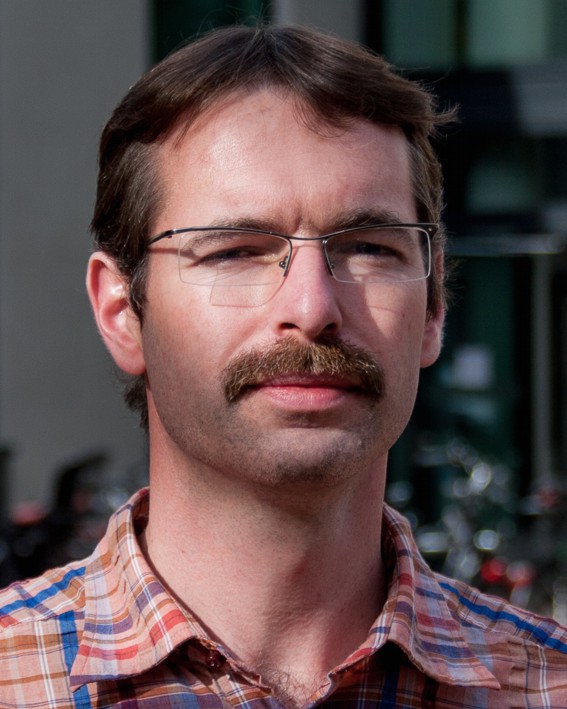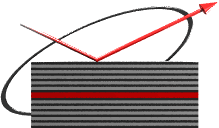|
Dr. Rüdiger Schmidt-Grund
|
|

|
Research / Projects
Current Projects |
Topologic effects in anisotropic micro-cavities
Polarization dynamics in multiferroics
Polariton BEC in nanorods
|
| |
| [Top of page] |
| |
Topologic effects in anisotropic micro-cavities |
| |
|
PI: Rüdiger Schmidt-Grund / Ulf Peschel (Uni Jena) |
| |
|
| |
|
funding period:
2017 - 2019 |
sponsor:
DFG |
funding program:
Research Grant |
funding ID:
DFG SCHM 2710/3-1 |
| |
|
| |
|
| |
|
| |
|
Abstract:
Aim of the project is the experimental realisation and theoretical understanding of topological interesting microcavities (MC), as well as the proof of protected photonic states and directed transport of photons and exciton-polaritons. The theoretical investigations of these exemplary systems here proposed are expected to form a basis for a generally new concept for the description of optical modes and their polarization in systems of low symmetry. Further, topological photonic systems are highly interesting for fundamental science as well as, regarding applications, can be expected to provide a milestone towards the realization of devices for on-chip optical data transport and processing. The capability of exciton-polaritons to build up a Bose-Einstein condensate at room temperature and above show further the potential of such topologic systems for application in quantum computing. As a general new concept, we will utilize special mode properties in optically biaxial systems, in which symmetry breaking is induced by the combination of the resonator structure and the optical anisotropy of the involved materials. Topologically nontrivial MC made out of optically anisotropic, otherwise optically linear, reciprocal and non-chiral cavity materials shall be experimentally produced, investigated and theoretically understood. The non-triviality shall be proven by means of properties (complex mode dispersion, polarization or rather pseudo-spin) of the cavity photons and excitonpolaritons. Using lateral structuring, the degeneracy of Dirac-like points shall be lifted for inducing of topological protected edge-modes and to enable corresponding transport of photons or excitonpolaritons. In this regard, the polarization state or rather the pseudospin of the particles is expected to be topological protected and thus can be used for experimental proof. The proposed concept does not need external fields, complicated meta-materials or per se topological non-trivial electronic systems and thus is very promising for practical applications. As based on our preliminary studies, the widely investigated and well known optically uniaxial semiconductors ZnO and GaN are very suitable as respective cavity materials. The orientation of their optical axis thereby must not be aligned parallel to the direction of the confinement of the MC. First, we will realise and investigate bare photonic MC, for the transparency spectral range of the used materials. At success, we will extend our investigations to the regime of the strong exciton-photon coupling (exciton-polaritons).
|
| |
| [Top of page] |
| |
Magneto-electro-optical interactions and their dynamics in oxide heterostructures |
| |
|
PI: Rüdiger Schmidt-Grund |
| |
|
| |
|
funding period:
2012 - 2019 |
sponsor:
DFG |
funding program:
Collaborative Research Centre (SFB 762) |
funding ID:
INST271/240-2,3 B3 |
| |
|
| |
|
| |
|
| |
|
Abstract:
Aim is to develop a remanently switchable optical waveguide, in which the switchable magnetisation or electric polarization fields of a ferroelectric, ferromagnetic, or multiferroic material is used to switch the properties of resonant or propagating optical modes as a signal. To this end we will investigate (1) basic optical and magneto-optical properties of, primarily, magnetic spinel´s and multiferroic BaTiO3/BiFeO3-composites; (2) the influence of the mentioned fields on the optical properties of an adjacent dielectric or semiconductor; (3) the dynamics of their switching in the fs- to ms-time-range.
|
| |
| [Top of page] |
| |
Quantum Gases and Liquids in Semiconductor Rods |
| |
|
PI: Rüdiger Schmidt-Grund, Marius Grundmann |
| |
|
| |
|
funding period:
2012 - 2018 |
sponsor:
DFG |
funding program:
Research Unit
(FOR 1616) |
funding ID:
SCHM2710/2-1,2 P1 |
| |
|
| |
|
| |
|
| |
|
Abstract:
Aim of the project is the design of optical modes in two or three dimensions in cylindrical resonator structures. Lateral leaky modes in wire-like resonators shall be altered in order to enhance the spontaneous or stimulated emission in the wire direction. Also two- or three-dimensional photonic mode confinement shall serve to manipulate the properties of strong light-matter coupling in cylindrical ZnO-, GaN-, and GaAs-based nano- and microresonators (photonic wire respective dot resonator structures). The core wires act as cavity, containing an optically active medium. For both purposes, we will conformally coat free-standing nano- and microwires with concentric Bragg reflectors by means of pulsed laser deposition.
By carefully controlling the optical mode design and the electronic properties of the resonator structures, different states of the bosonic quasi-particles, the so-called exciton-polaritons, build up in the strong light-matter coupling regime shall be experimentally achieved and investigated. Such states represent parametric oscillators in a medium-density regime and form Bose-Einstein condensates and polariton-superfluides in a high-density regime. The complex optical mode structure in such two-dimensionally confined photonic wire resonators shall be used to realize parametric interbranch scattering which enables the emission of entangled photons. Furthermore, we will utilize the strong dynamic character and the large propagation length of exciton-polariton Bose-Einstein condensates in ZnO-based resonators to establish guides for polariton condensates and fluids using photonic wire resonators.
|
| |
| [Top of page] |
Previous Projects
|
| |
| [Top of page] |
| |
Coherence properties of condensed exciton-polaritons |
| |
|
PI: Rüdiger Schmidt-Grund |
| |
|
| |
|
funding period:
2014 - 2015 |
sponsor:
DAAD |
funding program:
PPP Spain |
funding ID:
57050448 |
| |
|
| |
|
| |
|
| |
| [Top of page] |
| |
Bose-Einstein condensation and superfluids of exciton-polaritons at room temperature |
| |
|
PI: Rüdiger Schmidt-Grund, Marius Grundmann |
| |
|
| |
|
funding period:
2012 - 2015 |
sponsor:
DFG |
funding program:
Research Grant |
funding ID:
Gru1011/20-2 |
| |
|
| |
|
| |
|
| |
|
Abstract:
Es sollen Exziton-Polaritonen und deren Bose-Einstein Kondensate und Suprafluide in planaren ZnO-basierten Mikroresonatoren untersucht werden, insbesondere bezüglich deren Spin-Polarisation sowie Relaxations- und Streumechanismen.
Ziel ist die Realisierung von Quellen polarisations-verschränkter Photonen sowie die stabile Erzeugung von Bose-Einstein Kondensaten bzw. Suprafluiden bei Raumtemperatur und darüber. Die zugrundeliegenden physikalischen Prozesse sollen experimentell detailliert untersucht und theoretisch verstanden werden. Wie die Ergebnisse der ersten Förderperiode zeigen, sind bei diesen ZnO-basierten Mikroreso-natoren im Vergleich zu den "klassischen" Systemen einzigartige Möglichkeiten gegeben, neuartige Ein-blicke in die physikalischen Grundlagen insbesondere der Exziton-Polariton Spin-Polarisations-Eigen-schaften und der Dynamik von Exziton-Polariton Bose-Einstein Kondensaten zu erhalten.
In unseren ZnO-basierten Resonatoren sind Exziton-Polaritonen bis zu einer Temperatur von 410K stabil, und es wurden Bose-Einstein Kondensate bis zu einer Temperatur von 250K nachgewiesen. Diese Er-gebnisse legen nahe, dass die Erzeugung solcher makroskopischer Quantenzustände bei Raumtempera-tur und darüber hinaus in unseren Resonatoren relativ leicht erreichbar sein sollte. Die beobachteten Bose-Einstein Kondensate zeigen zudem bei gegenwärtig tiefen Temperaturen deutlich dynamische Ei-genschaften, welche in Hinblick auf Suprafluidität untersucht und genutzt werden sollen.
|
| |
| [Top of page] |
| |
Modeling of in-situ ellipsometry data for process control of optical functional planar and three-dimen-sional coatings |
| |
|
PI: Rüdiger Schmidt-Grund |
| |
|
| |
|
funding period:
2012 - 2014 |
sponsor:
SAB |
funding program:
Collaboration within "PRECIOS" |
| |
|
| |
|
| |
|
| |
|
Abstract:
confidential
|
| |
| [Top of page] |
| |
Exciton-polaritons in ZnO microre-sonators with oxide Bragg reflectors |
| |
|
PI: Marius Grundmann, Rüdiger Schmidt-Grund |
| |
|
| |
|
funding period:
2008 - 2011 |
sponsor:
DFG |
funding program:
Research Grant |
funding ID:
Gru1011/20-1 |
| |
|
| |
|
| |
|
| |
|
Abstract:
Es soll die Formation einer Quantenflüssigkeit bei Raumtemperatur oder sogar darüber
hinaus erreicht und nachgewiesen werden. Hierzu werden die optischen Eigenschaften
von Exziton-Polaritonen in epitaktischen Mikrokavitäten aus oxidischen Materialien
untersucht. Die (dynamische) Bose-Einstein-Kondensation dieser massiven, bosonischen
Quasiteilchen ist theoretisch für die angegebenen Materialien bis T =560 K vorausgesagt
worden und soll experimentell mittels Polariton-Phonon-Streuung und stimulierter
Polariton-Polariton-Streuung über "Pump-Probe"-Experimente erreicht werden.
Die Güte der Resonatoren soll optimiert und unabhängig von der energetischen
Abstimmung zwischen Photonen und Exzitonen untersucht werden. An Resonatoren
im Bereich der Abstimmung sollen die Eigenschaften der Kopplung zwischen Exzitonenund
Resonator-Moden vor allem in Abhängigkeit der Temperatur in einem weiten Bereich
studiert werden. Aus der Besetzungsdichte der bosonischen Zustände der Exziton-
Polaritonen soll das chemische Potenzial des Bose-Einstein-Kondensates in Abhängigkeit
von der Anregungsdichte ermittelt werden.
|
| |
| [Top of page] |
Scientific Collaborations
|
| |
| top |
Prof. Dr. M. Bayer, TU Dortmund, GER
Dr. C. Bundesmann, IOM Leipzig, GER
Prof. Dr. S.G. Ebbinghaus, Martin-Luther-Universität Halle-Wittenberg, GER
Dr. P. Eastham, Trinity College, Dublin, IRL
Dr. F. Frost, IOM Leipzig, GER
Prof. Dr. N. Grandjean, EPFL, Lausanne, SUI
Prof. Dr. J. Gutowsky, Universität Bremen, GER
Dr. T. Jakubczyk, Warsaw University, POL
Dr. R. Johne, MPI for the Physics of Complex Systems, Dresden, GER
Dr. M.D. Martín Fernández, Universidad Autónoma, Madrid, ESP
Prof. Dr. U. Peschel, Universität Erlangen, GER
Prof. Dr. C. Ronning, Uni Jena, GER
Prof. Dr. B. Rosenow, Universität Leipzig, GER
Dr. H. Schmidt, TU Chemnitz, GER
Prof. Dr. M. Schubert, University of Nebraska-Lincoln, USA
Prof. Dr. L. Viña, Universidad Autónoma, Madrid, ESP
PD Dr. T. Voss, Universität Bremen, GER
Prof. Dr. A. Waag, TU Braunschweig, GER
Prof. Dr. D. Zahn, TU Chemnitz, GER
Dr. J. Zúñiga-Pérez, CNRS-CRHEA, Valbonne, FRA
|
| |
| [Top of page] |
|

